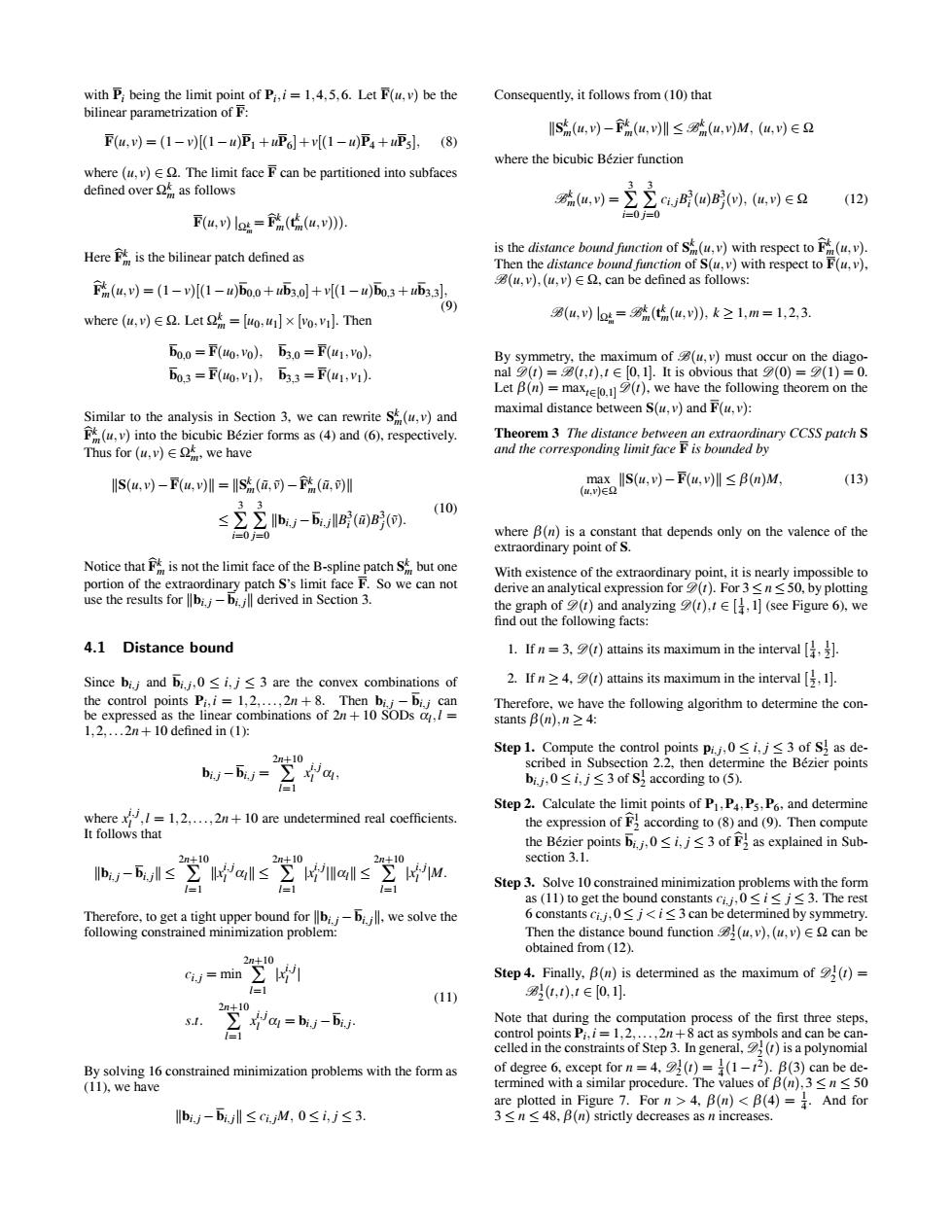正在加载图片...

eofL P be th Consequently.it follows from(h -0--+园+1-g+ 民a,明-ga,≤aM,g∈R an是Pcan bep Fia.v)loe=P(t(m.v)). Hr&is the hilingar natch defined as 第=-I-÷a-+ where iu,∈ett=lw.lx Ivpril Th =之=123 da Dau3ncaa胖CSS a小-1≤ 13到 ≤三三k,-5,io of the 4.1 Diatance bound 1.If n=3,r)scains its n %2e y--岂4 的二 1之…2a+0m Au-5s2"时a1s2I4ls2"w nethe n(a,以,(u,∈ean e roblems with The furm with Pi being the limit point of Pi,i = 1,4,5,6. Let F(u, v) be the bilinear parametrization of F: F(u, v)=(1−v)[(1−u)P1 +uP6] +v[(1−u)P4 +uP5], (8) where (u, v) ∈ Ω. The limit face F can be partitioned into subfaces defined over Ωk m as follows F(u, v) |Ωk m= F k m(t k m(u, v))). Here F k m is the bilinear patch defined as F k m(u, v)=(1−v)[(1−u)b0,0 +ub3,0] +v[(1−u)b0,3 +ub3,3], (9) where (u, v) ∈ Ω. Let Ωk m = [u0,u1]×[v0, v1]. Then b0,0 = F(u0, v0), b3,0 = F(u1, v0), b0,3 = F(u0, v1), b3,3 = F(u1, v1). Similar to the analysis in Section 3, we can rewrite Sk m(u, v) and F k m(u, v) into the bicubic Bezier forms as (4) and (6), respectively. ´ Thus for (u, v) ∈ Ωk m, we have S(u, v)−F(u, v) = Sk m(u˜, v˜)−F k m(u˜, v˜) ≤ 3 ∑ i=0 3 ∑ j=0 bi, j −bi, jB3 i (u˜)B3 j(v˜). (10) Notice that F k m is not the limit face of the B-spline patch Sk m but one portion of the extraordinary patch S’s limit face F. So we can not use the results for bi, j −bi, j derived in Section 3. 4.1 Distance bound Since bi, j and bi, j,0 ≤ i, j ≤ 3 are the convex combinations of the control points Pi,i = 1,2,...,2n + 8. Then bi, j − bi, j can be expressed as the linear combinations of 2n + 10 SODs αl,l = 1,2,...2n+10 defined in (1): bi, j −bi, j = 2n+10 ∑ l=1 x i, j l αl, where x i, j l ,l = 1,2,...,2n + 10 are undetermined real coefficients. It follows that bi, j −bi, j ≤ 2n+10 ∑ l=1 x i, j l αl ≤ 2n+10 ∑ l=1 |x i, j l |αl ≤ 2n+10 ∑ l=1 |x i, j l |M. Therefore, to get a tight upper bound for bi, j −bi, j, we solve the following constrained minimization problem: ci, j = min 2n+10 ∑ l=1 |x i, j l | s.t. 2n+10 ∑ l=1 x i, j l αl = bi, j −bi, j. (11) By solving 16 constrained minimization problems with the form as (11), we have bi, j −bi, j ≤ ci, jM, 0 ≤ i, j ≤ 3. Consequently, it follows from (10) that Sk m(u, v)−F k m(u, v) ≤ Bk m(u, v)M, (u, v) ∈ Ω where the bicubic Bezier function ´ Bk m(u, v) = 3 ∑ i=0 3 ∑ j=0 ci, jB3 i (u)B3 j(v), (u, v) ∈ Ω (12) is the distance bound function of Sk m(u, v) with respect to F k m(u, v). Then the distance bound function of S(u, v) with respect to F(u, v), B(u, v),(u, v) ∈ Ω, can be defined as follows: B(u, v) |Ωk m= Bk m(t k m(u, v)), k ≥ 1,m = 1,2,3. By symmetry, the maximum of B(u, v) must occur on the diagonal D(t) = B(t,t),t ∈ [0,1]. It is obvious that D(0) = D(1) = 0. Let β(n) = maxt∈[0,1] D(t), we have the following theorem on the maximal distance between S(u, v) and F(u, v): Theorem 3 The distance between an extraordinary CCSS patch S and the corresponding limit face F is bounded by max (u,v)∈Ω S(u, v)−F(u, v) ≤ β(n)M, (13) where β(n) is a constant that depends only on the valence of the extraordinary point of S. With existence of the extraordinary point, it is nearly impossible to derive an analytical expression for D(t). For 3 ≤ n ≤ 50, by plotting the graph of D(t) and analyzing D(t),t ∈ [ 1 4 ,1] (see Figure 6), we find out the following facts: 1. If n = 3, D(t) attains its maximum in the interval [ 1 4 , 1 2 ]. 2. If n ≥ 4, D(t) attains its maximum in the interval [ 1 2 ,1]. Therefore, we have the following algorithm to determine the constants β(n),n ≥ 4: Step 1. Compute the control points pi, j,0 ≤ i, j ≤ 3 of S1 2 as described in Subsection 2.2, then determine the Bezier points ´ bi, j,0 ≤ i, j ≤ 3 of S1 2 according to (5). Step 2. Calculate the limit points of P1,P4,P5,P6, and determine the expression of F 1 2 according to (8) and (9). Then compute the Bezier points ´ bi, j,0 ≤ i, j ≤ 3 of F 1 2 as explained in Subsection 3.1. Step 3. Solve 10 constrained minimization problems with the form as (11) to get the bound constants ci, j,0 ≤ i ≤ j ≤ 3. The rest 6 constants ci, j,0 ≤ j < i ≤ 3 can be determined by symmetry. Then the distance bound function B1 2(u, v),(u, v) ∈ Ω can be obtained from (12). Step 4. Finally, β(n) is determined as the maximum of D1 2 (t) = B1 2(t,t),t ∈ [0,1]. Note that during the computation process of the first three steps, control points Pi,i = 1,2,...,2n+8 act as symbols and can be cancelled in the constraints of Step 3. In general, D1 2 (t) is a polynomial of degree 6, except for n = 4, D1 2 (t) = 1 4 (1−t 2). β(3) can be determined with a similar procedure. The values of β(n),3 ≤ n ≤ 50 are plotted in Figure 7. For n > 4, β(n) < β(4) = 1 4 . And for 3 ≤ n ≤ 48, β(n) strictly decreases as n increases